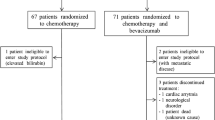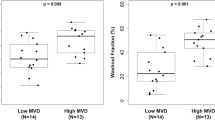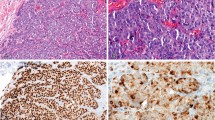Abstract
The intensity of angiogenesis as measured by the density of microvessels has been reported to be associated with a poor prognosis in invasive breast cancer in some, but not all, studies. The reasons for these discrepancies may be variations in the methodologies used. The monoclonal antibody used to identify the microvessels, the number of high-density areas or 'hotspots' counted and the type of value taken for statistical analysis (highest count or mean count) have varied between the different studies. We have assessed which of the three commonly used monoclonal antibodies provides the best visualization of microvessels in invasive breast cancer and have used methods that give reproducible data for the optimum number of 'hotspots' to count for each reagent. Thus, microvessels in formalin-fixed paraffin-embedded specimens from 174 primary breast cancers were immunohistochemically stained with monoclonal antibodies to FVIIIRAg, CD31 and CD34 and ten fields counted at 200 x magnification for each antibody. The highest count and the mean value of the highest of three, five and ten counts were used to examine the relationship between the density of microvessels and overall survival of patients with a median follow-up time of 7.1 years. Antibodies to CD31 and CD34 identified more vessels than antibodies to FVIIIRAg (median highest count per mm2: CD31 = 100, CD34 = 100, FVIIIRAg = 81). The monoclonal antibody to CD31, however, was the least reliable antibody, immunohistochemically staining only 87% of sections compared with 98% for the monoclonal to CD34 and 99% for the monoclonal to FVIIIRAg. There was a high degree of correlation between the number of vessels stained by the different antibodies, though there were some considerable differences in actual counts for serial sections of the same specimen stained by the different antibodies. Patients could be divided into two groups corresponding to those with high microvessel densities and those with low microvessel densities. Using Kaplan-Meier survival curves, there was a close association for all three antibodies between vessel density and survival whichever method of recording the highest vessel densities was used. Using log-rank tests and Cox's regression analysis, anti-CD34 gave the most significant results of the three antibodies, whereas a simple cut-off at the 75th percentile for the high and low groups produced the best association with patient survival. For anti-CD34 the highest microvessel density (P = 0.0014) and the mean value of the highest three microvessel densities (P = 0.004) showed a good correlation with patient death, whereas for anti-CD31 (P = 0.008) and anti-FVIIIRAg (P = 0.007) the highest count gave the best correlation using Cox's regression analysis.
This is a preview of subscription content, access via your institution
Access options
Subscribe to this journal
Receive 24 print issues and online access
$259.00 per year
only $10.79 per issue
Buy this article
- Purchase on Springer Link
- Instant access to full article PDF
Prices may be subject to local taxes which are calculated during checkout
Similar content being viewed by others
Author information
Authors and Affiliations
Rights and permissions
About this article
Cite this article
Martin, L., Green, B., Renshaw, C. et al. Examining the technique of angiogenesis assessment in invasive breast cancer. Br J Cancer 76, 1046–1054 (1997). https://doi.org/10.1038/bjc.1997.506
Issue Date:
DOI: https://doi.org/10.1038/bjc.1997.506
This article is cited by
-
Dynamic contrast-enhanced breast MRI features correlate with invasive breast cancer angiogenesis
npj Breast Cancer (2021)
-
Macroscopic optical physiological parameters correlate with microscopic proliferation and vessel area breast cancer signatures
Breast Cancer Research (2015)
-
The relationship between lymphovascular invasion and angiogenesis, hormone receptors, cell proliferation and survival in patients with primary operable invasive ductal breast cancer
BMC Clinical Pathology (2013)
-
Microvessel Density and Status of p53 Protein as Potential Prognostic Factors for Adjuvant Anthracycline Chemotherapy in Retrospective Analysis of Early Breast Cancer Patients Group
Pathology & Oncology Research (2012)
-
Immunostaining with D2–40 improves evaluation of lymphovascular invasion, but may not predict sentinel lymph node status in early breast cancer
BMC Cancer (2009)



